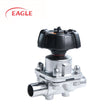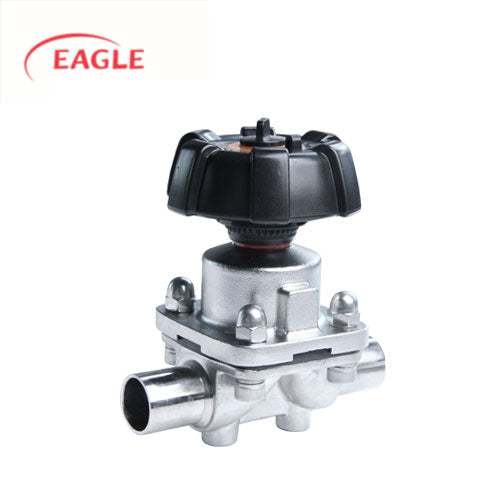☎+86-577-86826961
sales@eaglefittings.com

1/2" Manual Diaphragm Valve - 316L Sanitary/Aseptic Stainless ...
Free shipping
On all orders over $199
Special offers
Regular sales and discounts
Easy returns
Hassle free returns policy
Chat facility
Talk to a real person
Designed with a fully enclosed structure (no external fluid contact), it eliminates contamination risks, complying with strict sanitary standards. Available with tri-clover/clamp, butt weld, or thread connections, and backed by global manufacturing expertise (USA & China facilities), it’s ideal for sterile fluid control in pharmaceutical, food, and biotech applications.
FAQ
How does a manual diaphragm valve work?
Manual operation (e.g., handle) lifts/lowers the diaphragm to open/close the flow path; the diaphragm isolates fluid from external components, ensuring aseptic sealing.
What are the disadvantages of a diaphragm valve?
Diaphragm requires regular replacement due to wear; not ideal for long-term high-pressure/high-temperature use; limited flow control precision.
What are the two types of diaphragm valves?
Mainly weir-type (fluid flows over a weir) and straight-through type (linear flow path), distinguished by internal structure and flow direction.
What is the alternative to a diaphragm valve?
Ball valves or gate valves, preferred for non-aseptic, high-pressure, or high-flow applications due to better durability and flow efficiency.

|
Size |
L |
L1 |
K |
D |
C |
H |
|
0.5" |
108 |
102 |
65 |
12.7 |
50.5 |
103 |
|
0.75" |
126 |
120 |
87 |
19.05 |
50.5 |
103 |
|
1" |
126 |
120 |
87 |
25.4 |
50.5 |
122 |
|
1.5" |
160 |
140 |
104 |
38.1 |
50.5 |
160 |
|
2" |
193 |
150 |
114 |
50.8 |
64 |
190 |

| No. | Description |
| 1 | Cap |
| 2 | Handwheel |
| 3 | Screw |
| 4 | Valve Rod |
| 5 | Valve Cap |
| 6 | Valve Core |
| 7 | Diaphragm |
| 8 | Valve Body |
| 9 | Nut |

About Egle
ASME BPE range includes a comprehensive selection of tubes and fittings of varying dimensions and executions all compliant with ASME BPE standards. Made for safe and easy installation, its high quality and good weldability meet the standards of biopharmaceutical industries.

Designed with a fully enclosed structure (no external fluid contact), it eliminates contamination risks, complying with strict sanitary standards. Available with tri-clover/clamp, butt weld, or thread connections, and backed by global manufacturing expertise (USA & China facilities), it’s ideal for sterile fluid control in pharmaceutical, food, and biotech applications.
FAQ
How does a manual diaphragm valve work?
Manual operation (e.g., handle) lifts/lowers the diaphragm to open/close the flow path; the diaphragm isolates fluid from external components, ensuring aseptic sealing.
What are the disadvantages of a diaphragm valve?
Diaphragm requires regular replacement due to wear; not ideal for long-term high-pressure/high-temperature use; limited flow control precision.
What are the two types of diaphragm valves?
Mainly weir-type (fluid flows over a weir) and straight-through type (linear flow path), distinguished by internal structure and flow direction.
What is the alternative to a diaphragm valve?
Ball valves or gate valves, preferred for non-aseptic, high-pressure, or high-flow applications due to better durability and flow efficiency.

|
Size |
L |
L1 |
K |
D |
C |
H |
|
0.5" |
108 |
102 |
65 |
12.7 |
50.5 |
103 |
|
0.75" |
126 |
120 |
87 |
19.05 |
50.5 |
103 |
|
1" |
126 |
120 |
87 |
25.4 |
50.5 |
122 |
|
1.5" |
160 |
140 |
104 |
38.1 |
50.5 |
160 |
|
2" |
193 |
150 |
114 |
50.8 |
64 |
190 |

| No. | Description |
| 1 | Cap |
| 2 | Handwheel |
| 3 | Screw |
| 4 | Valve Rod |
| 5 | Valve Cap |
| 6 | Valve Core |
| 7 | Diaphragm |
| 8 | Valve Body |
| 9 | Nut |

Size
Grade